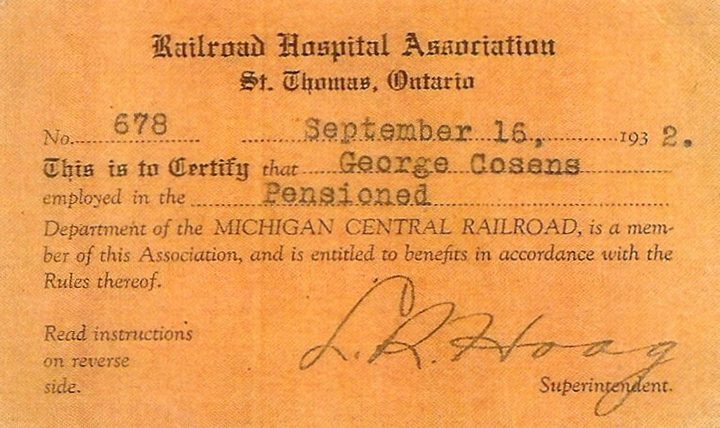Inducted in 2012
The first mention we have of the existence of the “Railway Hospital” is in 1884. This early institution was apparently conducted by the Railroad YMCA and was located at 574 Talbot Street on the second floor of the Acacia Block. This was the first cooperative medi-care operation in St. Thomas. It was formed by employees of the Michigan Central Railway and its associated lines.
By 1892, the hospital had moved to 723 Talbot Street (north west corner of Alma and Talbot Streets) and the matron was Mrs. Mary Culver. Members of the Association received benefits either at home or in the hospital and were carefully monitored by the railway doctor.
The first railway doctor of whom we have any record was Dr. William E. Smith who served in the capacity at least as early as 1892. Dr. James D. Curtis was named his assistant in 1899 and served the Association for many years thereafter.
Shortly after the Amasa Wood Hospital was opened in 1891, negotiations were entered into and eventually one or two wards were secured for the use of the Association members. A similar and satisfactory arrangement was extended by the Memorial Hospital and the St. Thomas-Elgin General Hospital until the Association ceased to exist.
During the early years of the 20th century, other groups sprang up which may have competed with the Railroad Hospital – or they may have even complemented it. From 1905 to 1911 the Canada Southern Sick Benevolent Association was in operation. The principals of the society were Charles Lowry and D. Managan (both blacksmiths), John Martin, W. H. Lucas and Philip S. Minshall, a foreman, who was secretary for all the time the Association was in existence.
Another group which lasted an even shorter period, of about four years from 1908 to 1911, was the Canada Southern Sick Benefit and Funeral Society. The officers throughout its brief life were: William Frost (president 1908-1911), D. Warnock, John Jones (who was a porter in the Dining Hall and who lived at the depot), E. A. Mitchener (secretary) and H. Laycock (treasurer).
The Hospital Association was referred to by various names throughout its existence – the most common variation being, the Railway Hospital Association. It was often referred to as the Michigan Central Railway Hospital Association.
North America Railway Hall of Fame Recognizing, Honoring and Preserving our Railway Heritage. The first president of the Association for which we have a record was George W. Babbitt (Chief Train Dispatcher) who presided from at least 1908 to 1910. Timothy HIckey served from 1911 to 1917 and Lewis N. Parsons (Chief Operator) presided from 1920 to 1930.
For many years the Association had monthly meetings, held on the first day after the MCR pay day in the MCR shops.
The first listed Chief Physician/Surgeon after 1900 was (in 1908) Dr. James Fulton, with Dr. J.D. Curtis as the Chief Assistant. In 1909, following Dr. Fultonʼs death, Dr. Curtis became the Chief Physician and Dr. Archibald C. Campbell, the Assistant. In 1916 Dr. Curtis left for service in the Great War and Dr. Campbell became Chief Physician and Surgeon with Dr. Perry O. King as Assistant – this continued until the mid-1920s when Dr. Curtis replaced Dr. King as Assistant. Dr. Campbell died in 1928 and was replaced by Dr. Douglas S. Carrie.
In about 1925, Leon R. Hoag, son of Roscoe Hoag, who was Chief Clerk at the Michigan Central Railroad, became superintendent of the Association, a full-time position he held officially for the next 45 years, when the Association was dissolved.
A universal system of hospital care in Canada became a prime focus of political discussion following the Second World War, and in 1957 John Diefenbaker’s government furthered this development. This followed the significant lead of Tommy Douglasʼ government in Saskatchewan, which in 1946 implemented the Hospital Insurance and Diagnostic Services Act. Lester B. Pearson’s government subsequently expanded this policy to universal health care with the Medical Care Act in 1966.
With the universal adoption of medicare the Railroad Hospital Association became redundant, but during its long existence of over 80 years, it served a most useful, and surprisingly efficient purpose, for the many railroad workers of the Canadian Michigan Central / New York Central System.


